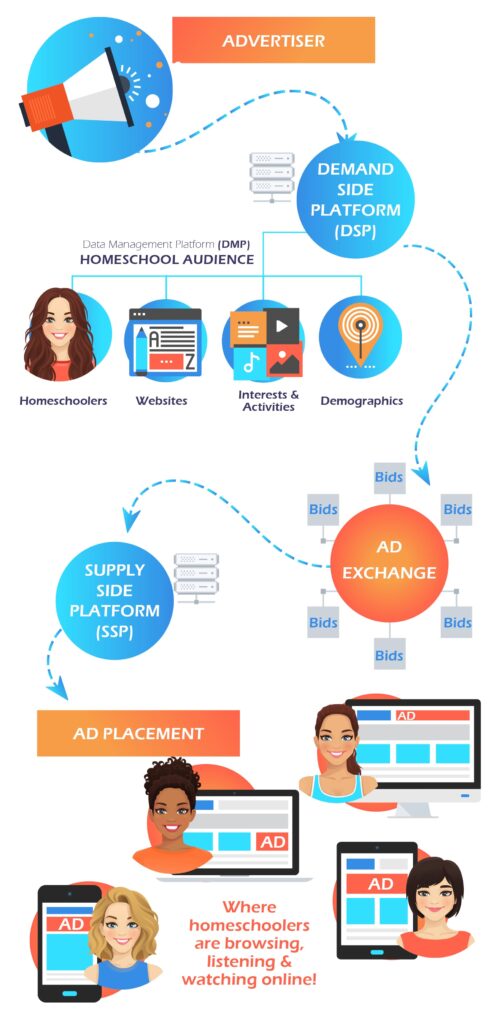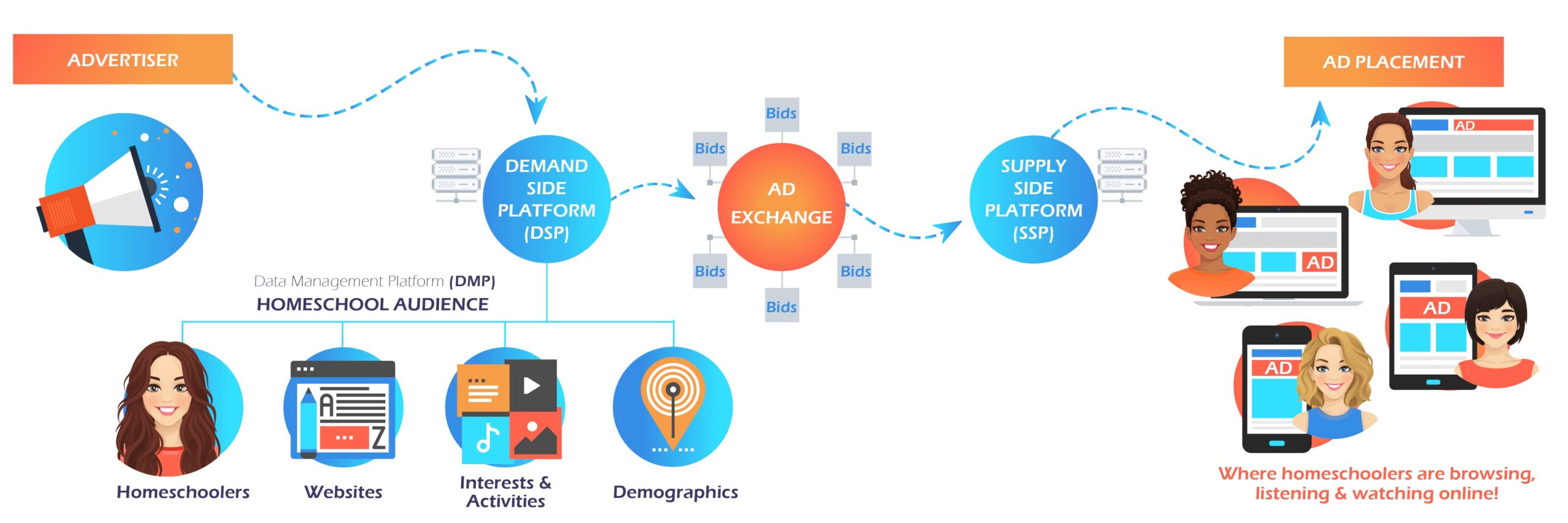Programmatic Ads
A BRIEF OVERVIEW
Delivering over 12 million ads per second, programmatic advertising is a network of advanced technologies that work together to automate the process of buying and selling digital advertisements.
For example, when a consumer is browsing a website that has ad spots available, based on the data collected on this consumer through online and offline resources, the ad exchange offers the ad spot for bidding. If this consumer meets the advertiser criteria for targeting and has the correct creative artwork size to fill the ad spot, bidding begins to take place. If the bid is won by the advertiser, the ad is placed. This all happens in less than 1 second.
In this article, you will learn to recognize programmatic ads with a brief overview of each component of the programmatic ad network and how they work together.
Before we dive into the overview, it’s important to have clarity on what a programmatic ad is and what it is not. Programmatic ads are not social media ads, nor are they search engine result ads. These ads are purchased and displayed within their own platforms.
Programmatic ads are served on any website, app, connected device, or streaming service. These can be a simple banner ad, animated HTML5 ad, native ads, audio ads, or video ads displayed on any digital device, from a laptop to a billboard.
The Network Components
Although there are over a dozen different types of companies that support the programmatic industry, many work under the umbrella of other services. For example, when you view the programmatic image by LumaScape in the sidebar, media planning, creative optimization, or tag management are often offered within many DSPs.
That said, this overview will cover four major components utilized by Well Planned Advertiser platform.
Demand Side Platform (DSP)
In the world of programmatic ads, the Demand Side Platform (DSP for short) is the platform advertisers use to access the ad exchange with real-time bidding. Most DSPs offer services that include the ability to track your website data, create audiences using Data Management Platforms (DPM), and manage your ad creative. Most importantly, DSP allow advertisers to create, deploy, monitor, and adjust campaigns in real-time.
As you can see in the LUMAscape, there are a host of DSP, each offering the same basic services but with different requirements for on-boarding or fee structures. The models vary; currently there are 4 model types:
- Minimum monthly ad spend.
Example: minimums of $25,000 – $500,000 per month - Minimum campaign spend over limited time period.
Example: $5,000 per campaign that lasts 2 weeks. - Monthly fee to access platform.
Example: $500 – $5,000 a month plus ad spend. - Percentage of ad spend plus monthly fee.
Example: $99 a month plus 50% – 75% ad service fee.
Every $100 you spend, an additional $50-$75 is added as a fee.
In each of the examples above, the advertiser is required to create target audiences using their own website data or built audiences to target through the DMP.
Well Planned Advertiser DSP
Well Planned Advertiser integrates a community audience system with four DSP integrations to create a unique niche market platform.
- Microsoft XandR
- Comcast Beeswax
- Google DV360
- Amazon DSP
The DSP for Niche Markets
Understanding the unique challenges faced by niche markets, from cyclical sales seasons and smaller audiences to limited budgets, Well Planned Advertiser has developed a revolutionary DSP platform. With built-in community audiences and no monthly fees, small to medium-sized businesses can access programmatic ads, targeting audiences at a fraction of the cost.
In addition, we walk you through the process step by step. We work to train the small business owner, the ad manager, the advertising director, or a marketing team in the most effective way to implement programmatic ads!
Data Management Platform (DMP)
Going beyond niche, built-in audiences, you can create any number of distinct audiences based on a plethora of demographics. Technology today allows purchase, interest, and activities to be recorded. Access to this data is acquired through Data Management Platforms (DMP).
A backbone to programmatic advertising, a DMP collects and organizes audience data into anonymized customer profiles. These profiles are made available to DSP platforms in order to create targeted audiences.
Well Planned Advertiser utilizes over a dozen data partners which allow you the ability to fine tune the audience that will respond best to your brand.
Ad Exchange
The ad exchange is a digital marketplace where advertisers (DSP) buy available ad spots on publishers’ sites (SSP) using a real-time bidding system (RTB). Ad exchanges are driven by a simple demand and supply mechanism.
Ad inventory is any available space on publishers’ websites, apps, or streaming services. The buying and selling of this inventory happens through real time bidding (RTB) in which several participants bid on the available ad inventory. The highest bidder wins the right to display their ads on the selected ad space.
Supply Side Platform (SSP)
DSP allows for advertisers to build audiences using a DMP and bid on ads through the ad exchange. That leaves one last element to complete the circle of programmatic ads, the supply-side platform (SSP).
A supply-side platform is software used to sell advertising in an automated fashion. SSPs are most often used by online publishers to help them sell display, video, and mobile ads. A supply-side platform is the publisher equivalent of a DSP.

Quick Reference
Network Components
- Demand-Side Platform (DSP)
- Data Management Platform (DMP)
- Ad Exchange
- Supply-Side Platform (SSP)

Advertising Channels
The ability to target goes beyond the type of ad to allow you to choose where it’s displayed.
DISPLAY ADS
An image or HTML5 animated creative displayed on websites and apps
NATIVE ADS
An image accompanied by a header and subtitle displayed within the content of a website, made to resemble editorial content.
AUDIO ADS
A 15-, 30-, or 60-second advertisement accompanied by coordinated images played and displayed on podcasts and music streaming apps
VIDEO ADS
The fastest growing ad format; available instream, displaying your ad within the video player before playing the video content, and outstream, where videos are displayed in the midst of content of any website
DESKTOP / MOBILE WEB
Enables limiting of your ads to display on only desktop or mobile, whether you have animated HTML5 or video ads
MOBILE IN-APP
An adverstiement that can save on impression costs by narrowing your campaign focus; primarily for target audiences found in apps
CONNECTED TV
Ads that target viewers watching TV content via an internet-connected device such as a smart TV, gaming console, or streaming device
DIGITAL OUT OF HOME
Ads displayed on billboards, LED screens, and digital signage placed in high-traffic public spaces


About the Author
Rebecca Farris
As founder and developer of Well Planned Advertiser, Rebecca has built businesses within niche markets for over thirty years. With a desire to create solutions, always with an eye on the future, Rebecca enjoys teaching and training others, bringing clarity and simplicity to complex issues.
A lifelong autodidact with a passion for technology, advanced pattern recognition, and creative design, Rebecca strives to understand people and markets through studying theories and models. Her current favorite are Meyers Briggs cognitive function theory, generational theory, and the Grave model, also known as Spiral Dynamics.
LET US HELP
Hire a DSP Specialist
Whether you are a small business owner, advertising manager, or marketing team director, our DSP experts can help! We offer guidance from pixel strategies and installation to creating HTML5 ads and implementing a comprehensive annual marketing strategy.



